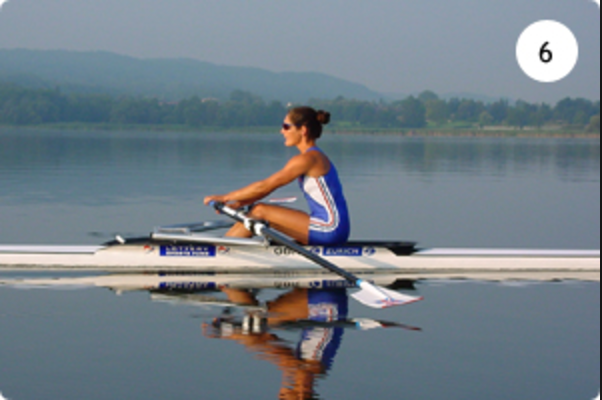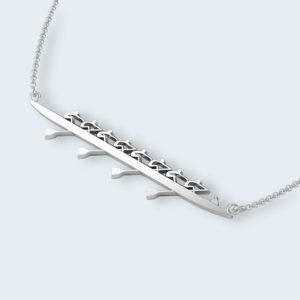I row in a quad scull and we did an interesting outing this week which I want to share.
If you coach yourselves or if you are a coach and want to use this pattern of learning for your own crews.
Before you start teaching rowing drills
You will need to read this article about Getting Ready to use exercises and drills.
For the specific drills in this article you will also need.
- Speed measurement tool in the boat (like a Coxmate GPS or NK Speed Coach)
- A crew who is keen to learn, experiment with new things and discuss what they observe
- All read this article about the Recovery in the rowing stroke before the outing. This will ensure you all have the same understanding about what we’re trying to achieve.
I use drills and points of focus for the crew while rowing continuously as a way to get everyone doing the same thing and thinking about the same thing at the same time. When doing this, I always try to give the crew a minimum of 10 strokes to focus on that one thing before introducing something else. This gives them the best chance of making a change and holding onto that change and recognising that they have made a change which they could feel or see. This helps the whole crew get a common understanding of what we’re trying to achieve.
First drills for the recovery
The exercise began was at the finish making a strong finish using a posture of high elbows, and ensuring that the recovery


began with arms, body, slide. We made the finish power greater by focusing on accelerating the oar handles towards the finish. A strong finish to the power phase is essential before making adjustments to the recovery.
Poise on the recovery – the photo shows Tracy Langlands, British Lightweight sculler rowing at Varese. She is on the recovery, her body is poised, but not tense, she is approaching half slide, her legs are loose and relaxed, her torso erect and poised but not straining, her arms are extended but not rigid. This photo is taken from ebook, British Rowing Technique
Then I introduced the concept of jelly legs. This is when your legs are very soft and must become fully relaxed after you get onto the sliding part of the recovery. It is important to note that you should not transition into a jelly leg state until you are already rolling up the slide. This is probably around the one quarter slide mark.
What are jelly legs? When stationary show the crew what a very loose calf and thigh musculature feels like. Get them to sit at half slide and to use their hands to tap the back of their legs and calves so the muscles waggle around in a complete state of relaxation. They must know what this feels like before they are able to reproduce it during rowing. I describe this as having the muscle “dripping” off the bone. When rowing the cycle takes the form of tension and relaxation. Teaching your crew how to increase their relaxation and “turn off” the muscles used in the power phase, will give more rest and allow greater tension in the power phase. Without relaxation, you get tired very quickly.
We then practised adding the jelly legs into our regular paddling and observed what happened to the speed of the boat when we introduced the drill. We were doing 10 strokes at a time with jelly legs and then 10 strokes back as normal, repeated over 1000m.
What we noticed was that the average boat speed on a 500 m split dropped and the meters per second boat speed increased when we added in the jelly legs. However we also noticed that the rating fell off and became fewer strokes per minute – these two things are connected. So we were making the boat go further and faster each stroke. #Win
Put yourself under pressure
For the last part of the outing we tried to do some rating changes while maintaining the jelly legs feeling. We chose to move from/rates of 17 to 19 SPM and then up to 21. This was because our paddling had naturally been around the rate 17 during our practice. Do not be afraid of choosing odd-numbers! We were watching the boat speed split at each rate change. We agreed to make the change in rate over 3 strokes, and then to call a jelly legs 10 strokes, maintain that for as long as we could (the feeling erodes because you aren’t skilled at holding the change); after 20 strokes total, we then changed the rating again over 3 strokes, called the jelly legs and held it for 20 strokes and made another change.
Doing this at firm pressure is essential so that you have that accelerated finish (described at the start of the article) and you get a greater contrast between the tension of the power phase and the relaxation of the recovery.
UPDATE 2018: Further tips on the ‘jelly legs’ drill
Tell us how you go in your crew.








This Post Has 2 Comments
how do jelly legs if the same muscles need to move you up the slide to the catch?
Hi Mak
When the boat already has momentum from your previous power stroke, you will find that you can get forward movement up the slide without activating those muscles…
This works well at low rates, when you try to do it at higher rates, you have to use the muscles (a little bit) to get up the slide.
Therefore, our advice is to practice jelly legs at low rates – and don’t worry if the rate drops a bit while you’re acquiring the skill to relax the muscles when they aren’t needed. Then later on, try doing it at say rate 24 and see if you can still do the relaxation and maintain the rating.
Rebecca